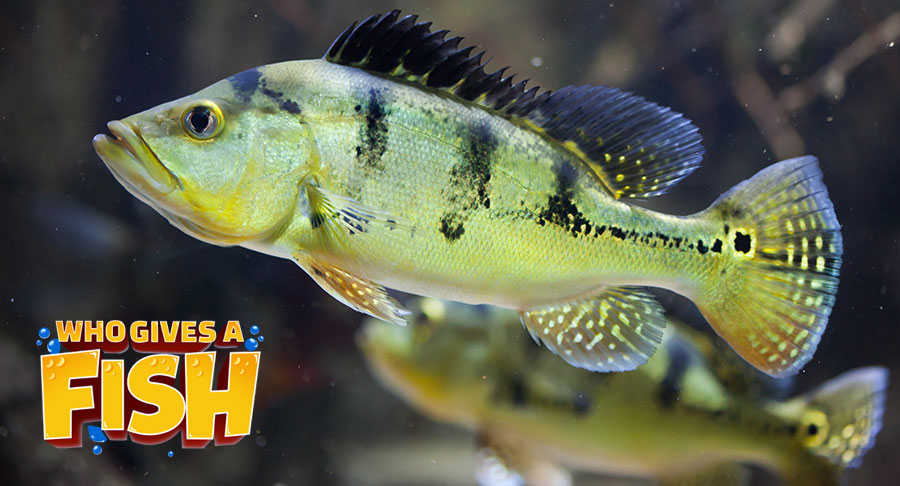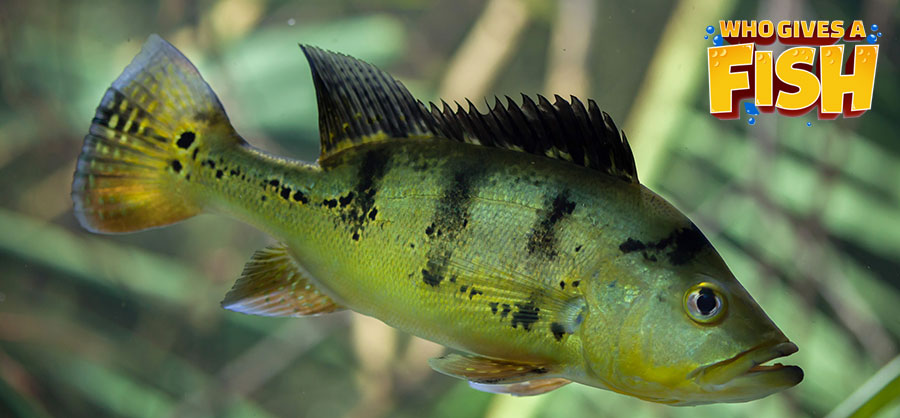Peacock Cichlid
The Peacock Cichlid, Cichla ocellaris, is a very large fish, best suited towards a big display tank. They generally display colors of greens, yellows and whites. Some people mistake this Cichlid for a bass as they look very similar and grow to bass size (up to 30 inches!). Other names commonly used for this Cichlid are the Butterfly Bass, Eye Spot Cichlid and the Peacock Bass. They owe their relevance to the Peacock due to their spots and patterns on their tails.
- Experience Level: Advanced – Expert
- Hardiness: Difficult
- Minimum Tank Size: 200 gal (760 L)
- Maximum Size: 30 in. (76 cm)
- Temperament: Aggressive – Predator
- Temperature: 75 – 82° F (23.9 – 27.8° C)
- pH Range: 6.5 – 7.5
- Water Hardness: 5 – 12 dGH
- Diet: Carnivore
Table of Contents
Introduction
Aquarium Setup
Difficulty
Feeding
Breeding and Social
This Cichlid is very intelligent and will display similar traits to the Oscar Cichlid with its keeper. They are playful fish, however it is highly recommended that anybody thinking of purchasing and keeping one of these fish, plan a very large aquarium with massive amounts of filtration. The Peacock Cichlid is a very large fish and not for a standard sized home aquarium (at least once they get over 5-7 inches)
While juveniles can be kept in smaller aquariums along with raising fry, a very large display tank for mature specimens is required and it is highly advised against trying to keep a mature specimen in a small tank.
A big problem with newbies to the hobby is that they purchase this fish in error and eventually neglect to upgrade their tanks. Often these amateur aquarists will then release these fish into the wild as they are unable to maintain them, and this is strictly advised against due to the hazards this places on the natural environment and indeed the fish itself. Please use due diligence before acquiring a Peacock Cichlid.
Aquarium Setup
Tank sizes required to house mature Peacock Cichlids usually utilize a sump, however, multiple large canister filters are also sufficient if they are turning the tank volume over several times per hour. Large Cichlids such as the Peacock produce a large bioload and excellent filtration is essential.
This big Cichlid requires large swimming areas in your aquarium and securing your aquascape is a must, as any loose rocks or equipment will easily fall, potentially causing damage to the fish and your aquarium.
Sand and or small gravel substrate is preferred, however it does not need to be deep. Java Ferns and Anubias usually survive as it is uncommon for this Cichlid to pull them out or eat them, however, underfeeding or extra aggression can still see these plants uprooted.
Peacock Cichlid Aquarium Guide
- Minimum Tank Size: 200 gal (760 L)
- pH Range: 6.5 – 7.5
- Water Hardness: 5 – 12 dGH
- Temperature: 75 – 82° F (23.9 – 27.8° C)
- Lighting: Normal lighting
- Substrate: Sand – Fine Gravel
- Brackish: No
- Water Flow: Moderate
- Tank Region: All areas
Difficulty
The main difficulty in keeping this Cichlid is its size and tank requirement. Growing up to 30 inches long, the Peacock Cichlid needs a very large tank, preferably over 200 gallons in size. Water quality is also an issue, as you will need to be turning over the entire tanks volume at least 5 to 6 times per hour at a minimum.
It is not considered a community fish, and most other fish will be eaten. Larger fish that can hold their own will likely still be attacked and bullied until they become weak and die. It is best to be kept alone or with several other Peacocks as long as you can provide enough tank volume.
It is recommended for advanced to expert level aquarists only.
Feeding
A carnivore by nature, this Cichlid prefers live foods and unless trained otherwise, can be difficult to feed cut foods. If you raise them from juveniles, you can easily feed them cut meats, however, wild specimens or larger ones that have been brought up on live foods won’t eat cut foods easily. Some keeps have tried to fast their Peacocks for several days to encourage chopped food consumption, with mixed results.
If your Peacocks are eating other live live foods, you can feed them Cichlid specific pellet food and other foods such as crickets, worms, shrimp, mollies, guppies and goldfish. Cut, non oily fish can also be offered.
Foods high in animal fats such as beef, pork and chicken products are not recommended as these foods can cause digestion issues and eventually lead to the death of these Cichlids. A simple rule of thumb is that if the food source (with the exception of pellets) is not from its natural environment, then it is not advised to be fed.
Peacock Cichlid Feeding Guide
- Diet: Carnivore
- Frequency: Several times per day
- Pellet Foods: Cichlid specific pellets
- Live Foods: Live fish such as mollies, guppies, goldfish and insects such as crickets and worms
- Meat Foods: Non oily meats such as cut prawns and fish. No warm blooded animal meats or organs.
- Vegetable Foods: Occasionally
Breeding
Mature males can display a nuchal hump on the forehead. You can also identify older specimens by their vents; males vents resemble oo while female vents resemble 0o.
Females begin spawning with an average of 2500 eggs. Older, more mature breeders can lay up to 15,000 eggs. Like many Cichlids, The Peacock Cichlid lays its eggs on cleaned, flat surfaces such as stones and large pots. Given their size, they are rarely bred in captivity, however commercial breeders often breed these fish in large ponds and breeding tanks of commercial size.
Social
The Peacock Cichlid is an aggressive predator. It is advised to keep them alone or with other Peacocks of a similar size only. Other smaller fish will simply become food or bullied to death. It is commonly noted to be tolerant of large cleaner fish such as the Plecostomus.



